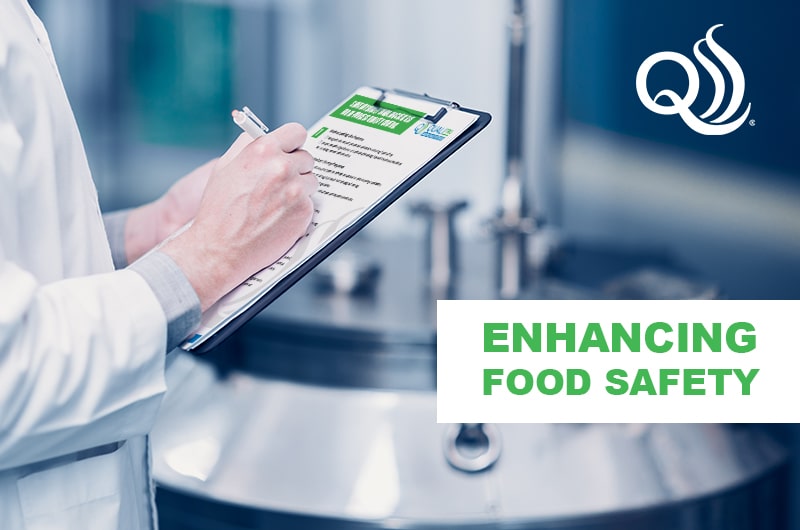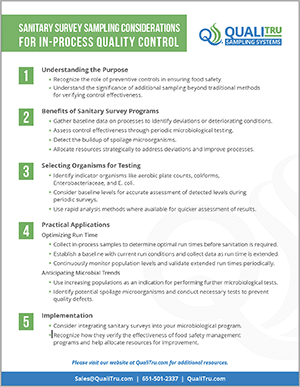Leveraging Sanitary Survey Sampling for In-Process Quality Control
Ruth Petran, PhD, CFS, global food safety and public health expert, explores the world of sanitary survey sampling, a potent tool for bolstering in-process quality control in food plants. See the Author Bio at the end of the post.
In a typical food plant, appropriate preventive controls are implemented to address the inevitable hazards from a variety of sources to ensure that the resulting products are safe. As part of these programs, we traditionally think of sampling ingredients or finished products to help verify the effectiveness and thorough implementation of these controls. Many food companies adopt these approaches; others who currently do not, might want to consider their usefulness.
Understanding Sanitary Survey Sampling
Additional sampling and testing can be helpful in monitoring processes and for further verification of preventive controls. These can be described as in-process sampling or sanitary surveys. The International Commission for the Microbiological Specifications for Foods1 describes these supplementary tests as part of a microbiological program and highlights several instances where their use can be incorporated.
The benefits of implementing a sanitary survey program include:
- Gathering baseline data about a process and its capability. This can help inform when a process is trending out of control, giving an indication of conditions that may be steady or starting to deteriorate. Analyzing trends in these data is a key part of this activity.
- Assessing the effectiveness of a particular control by conducting periodic microbiological testing of paired samples, such as before and after a blanch or cook step or the addition of an antimicrobial.
- Detecting buildup of spoilage microorganisms.
- Focusing resources where they are needed for improvement or to address deviations.
Selecting the Right Organism to Test
Typically, sanitary surveys involve testing for indicator organisms such as aerobic plate count, coliforms, Enterobacteriaceae, and sometimes E. coli. When choosing the optimal organism to test for it is important to know the baseline level that might be expected to help in assessing the detected levels from the periodic sanitary survey sampling. Typically, samples are collected during the production run through a sample port or by taking a portion of the food product from the line or a swab of the equipment. Rapid analyses methods can be used when available to facilitate more rapid assessment of results.
The Compendium of Methods for the Microbiological Examination of Foods2 summarizes helpful information related to the analyses of these organisms:
- Aerobic plate counts – gives an estimate of the level of microorganisms in a product.
- Coliforms – are a group of very diverse organisms but their presence can help assess the effectiveness of manufacturing processes or sanitation.
- Enterobacteriaceae – can be useful to inform about the overall hygiene of the environment as they are typically easily inactivated by typical sanitation practices. They are also helpful when assessing the effectiveness of a heat processing step.
- E. coli – since this organism is most often associated with fecal matter, its presence may be a valid indicator of such contamination.
Practical Applications of Sanitary Survey Sampling
We touched some on the utility of such sanitary survey samples. Here are a couple additional examples demonstrating the value of collecting and testing in-process samples.
- Optimizing Run Time: A facility may want to explore lengthening their run time to maximize their productivity and better enable their fulfillment of customer orders. Collection of in-process samples of their food product or of swabs of residual product on the equipment can be helpful to determine an ideal run time before there is a need to shut down to perform sanitation. To implement this:
- Collect data from the current run conditions to establish a baseline.
- As the run time is lengthened, continue to collect samples to determine how high the population levels may go and when they reach an unacceptably high level. Trial this several times to get representative data.
- After a new run time is determined, best practice is to collect data periodically to verify that the extended run time is still valid.
- Anticipating Microbial Trends: Another instance where sanitary survey sampling could be helpful is to indicate when further microbiological tests or analyses might be warranted. For example, increasing populations might indicate that a buildup of spoilage microbes, such as lactic acid bacteria, yeasts, or mold is occurring. Since these could lead to quality defects in the food, knowledge of the conditions under which this might occur is helpful to know. This can then allow you to perform further tests for unacceptable microorganisms as appropriate.
Implementing Sanitary Surveys: A Necessity
Overall, it is suggested that you consider the value of implementing a sanitary survey as part of a microbiological program in a manufacturing process. Implementation can help verify the effectiveness of food safety management programs within a food process and direct additional resources to pinpoint areas for improvement.
FREE Downloadable Guide: Sanitary Survey Sampling Considerations
Elevate your food safety standards with our comprehensive Sanitary Survey Sampling Considerations for In-Process Quality Control guide. This checklist guides the user through each essential step in leveraging sanitary surveys to fortify quality control measures. From understanding the pivotal role of preventive controls to practical applications like optimizing run times and detecting microbial trends, this checklist illuminates the path toward implementing effective and strategic sanitary survey programs. Explore each section for a detailed roadmap on how to integrate these practices seamlessly into your existing protocols, ensuring robust food safety management and continual improvement.
Intrigued by the power of in-process sampling?
Contact QualiTru to learn how our systems elevate your quality control.
Reference: [1] Swanson, K. M., Buchanan, R. L., Cole, M. B., Cordier, J. L., Flowers, R. S., Gorris, L. G. M., ... & Zwietering, M. H. (2011). Microorganisms in foods 8: use of data for assessing process control and product acceptance. Springer Science+ Business Media. [2] Salfinger, Y., & Tortorello, M. L. (Eds.). (2015). Compendium of methods for the microbiological examination of foods. American Public Health Association.
Resources
Additional Blogs by Ruth Petran
Importance of Hazard Analysis to Ensure Food Safety with Emerging Food Trends
Preventing Post-Process Contamination: Don’t Lose Sight of the Basics
Training
Why Process Monitoring & Aseptic Sampling Information Sheet
Training Videos
Printable Application Site Schematics






